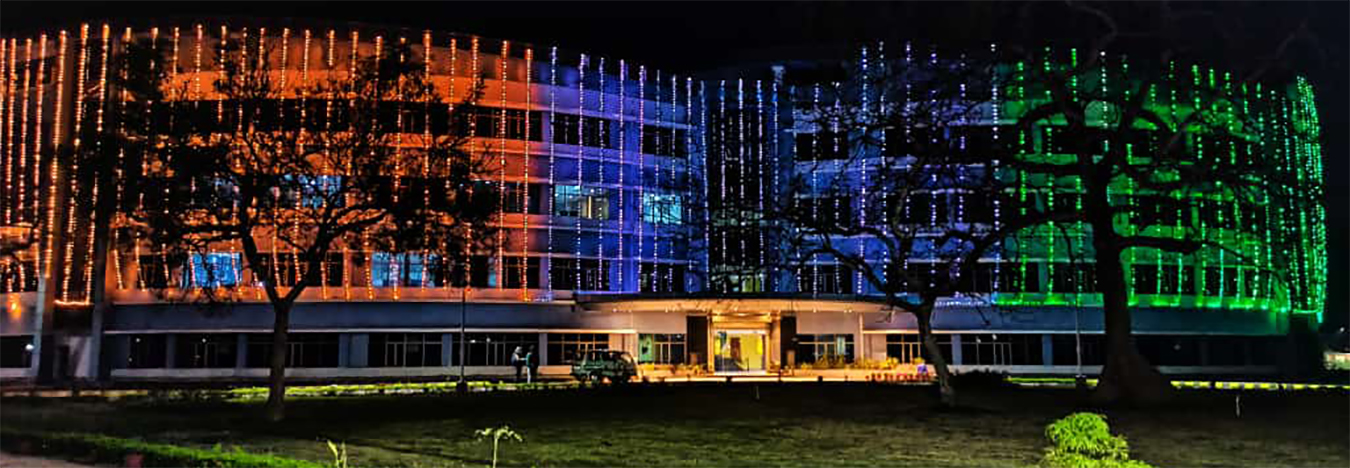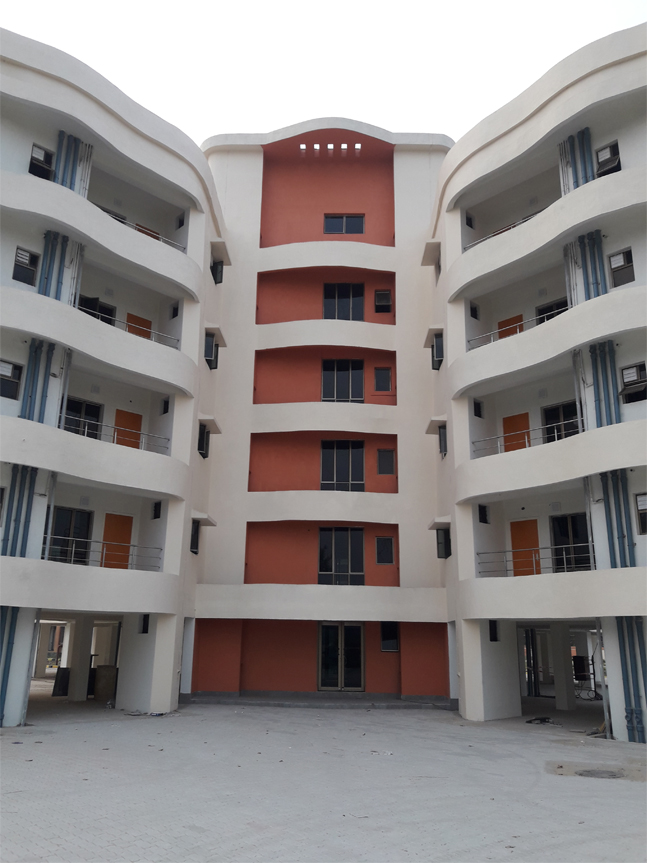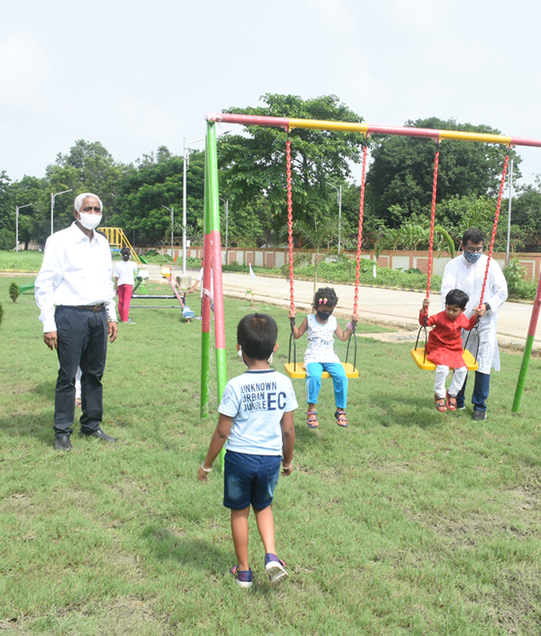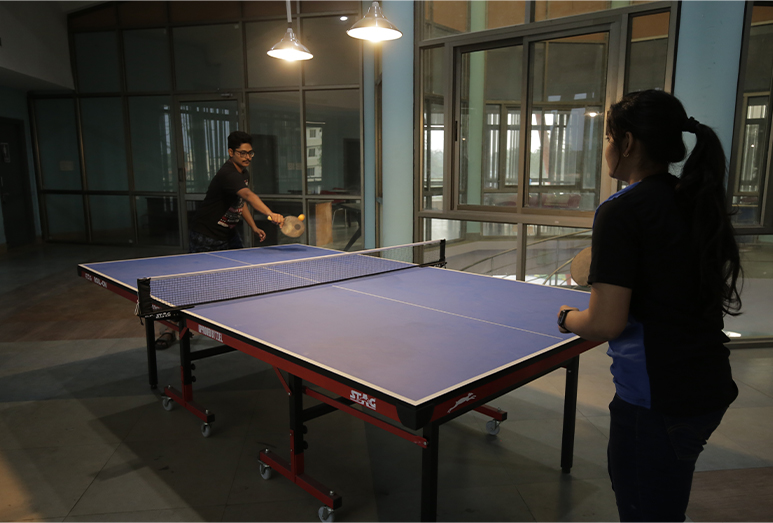
National Institute of Biomedical Genomics (NIBMG) is part of an Educational Hub in Kalyani, West Bengal where other premier institutions like Indian Institute of Science Education and Research-Kolkata (IISER-Kolkata), All India Institute of Medical Sciences-Kalyani (AIIMS-Kalyani), Kalyani University, Jawaharlal Nehru Memorial Hospital and Medical College, Maulana Abul Kalam Azad University of Technology (MAKAUT), Indian Institute of Information Technology (IIIT), Bidhan Chandra Krishi Viswabidyalaya (BCKV), West Bengal University of Animal Husbandry and Fishery Sciences, National Dairy Research Institute (NDRI-ICAR), JIS Engineering College are located within a distance of 5-7 kilometers. National Institution of Pharmaceutical Education and Research (NIPER) is also coming up with their new campus just next to NIBMG.
In order to create the necessary physical infrastructure to conduct and promote cutting edge research in biomedical genomics NIBMG has been built up in a thirty acre (1,21,404.8 Sqm) pollution free green campus in Kalyani, approximately 40 km from the International Airport at Kolkata and 1 km from Kalyani-Main railway station.

The site is more or less rectangular in shape, level land, with a spectacular outlook on its southern edge to a large inland water body. The campus comprises the Main Academic/Research Building on five levels housing all research laboratories, administrative block and Faculty offices. Residential Facilities with requisite amenities, for Faculty and Students, Recreation Facilities with FOOTBALL/ CRICKET GROUND, BADMINTON COURT, Gymnasium, CHILDCARE FACILITY (CRECHE) and a State of the Art Auditorium for conducting Seminars are also there or being built. Indoor sports room houses Carom and Table Tennis facilities. The Campus is envisaged to exceed international benchmarks for such Institutes.
The STUDENT HOSTEL has 96 units with each unit comprising of two single occupancy rooms and one shared bathroom, thereby having a capacity to accommodate a total of 192 students. The GUEST HOUSE has 24 single occupancy rooms, 24 double occupancy rooms and 6 suites. The CANTEEN caters to the entire NIBMG community providing breakfast, lunch, evening tea & snacks and dinner. We also have on campus medical facility with visiting Physician.
The campus is highly secured with CC cameras installed at important points and under 24X7 surveillance by trained professional security guards.
E-rickshaws are available just outside the main gate to take you to Kalyani main railway station and to the grocery/ stationary/ medicine shops next to it (2-3 minutes ride).
NIBMG members enjoy a vibrant academic and campus life with Scientific and Popular Lectures by eminent visitors, weekly Research Seminars & Journal Clubs followed by informal get together over tea and snacks (Friday Happy Hour !!). Apart from these, there are also cultural activities on the occasions of Institute Day, Foundation Day, Rabindra Jayanti and Hindi Diwas. Annual Retreat is another event of attraction. There are also Annual Cricket and Carom Tournaments with active participation from NIBMG community.
The Master Plan of the Campus has been developed with the following aims :
Creating a coherent and rational framework for present as well as future requirements
The total site has been demarcated into interlinked zones such as public zone, residential zone, institute zone, recreation and community zone. Each zone can develop and expand in a compartmentalized and prioritized way without affecting the functioning and ambience of the Institute
Fully realizing the architectural potential of the site with respect to its waterfront location
A visual axis is created right from the main entry via a magnificent tree lined avenue to the scriptural water tower anchoring the water front plaza with landscaped seating areas and jogging trails
A secondary axis is generated along the north-south axis, the Main Buildings being oriented towards it for optimum benefit for energy efficiency considering solar path at the site. This axis is also aligned with the prevailing wind direction
Creating a beautifully landscaped pedestrian friendly campus with an ambience suitable for advanced research
Creating a beautifully landscaped pedestrian friendly campus with an ambience suitable for advanced research


The Main Building with its distinctive design is an architectural landmark, well suited to its function.
The undulating overlapping roof structure reflects the twisting double helix structure of the DNA genome which is the underlying genesis of the research undertaken at the Institute. This theme is reflected both in the curved flanks of the building as well as in the section.
The built volume is interspersed with naturally ventilated atriums bringing daylight into the interiors. The atriums are ringed with circulation spaces with connecting bridges. These enable a high degree of interaction and collaboration between Faculty, Researchers and Students.
The various functions catered to in the building viz. teaching, administration, are demarcated level-wise and zone-wise.
The work spaces are optimally daylit. The correct orientation, plan depth, along with adequate shading devices and glazing specifications achieve this aim.
The Laboratory Zones overlook the water body. Interspersed service ducts and a continuous peripheral service corridor ensure ease of maintenance and future flexibility. A glass fronted elevator rises in the atrium connecting the two Laboratory Blocks.
The curved aspect eliminates the `matchbox monotony’ generally found in academic research environments.
The Campus is an exemplary `green campus’. Some of the measures adopted are :
The contract documents detail out sustainability measures to be adopted right from the construction stage
Use of waste material such as fly-ash for non-structural purposes
The Energy Conservation Building Code (ECBC) 2007 has been adhered to in the design of electrical and mechanical systems
Existing trees have been retained in the planning. In addition 2000 more trees are being planted, of indigenous variety.
Paved area on Campus has been kept below 25% of site area in order to reduce heat island effect.
The entire storm water is channeled and stored in a rain water harvesting tank, next to a massive existing banyan tree which has been retained.
